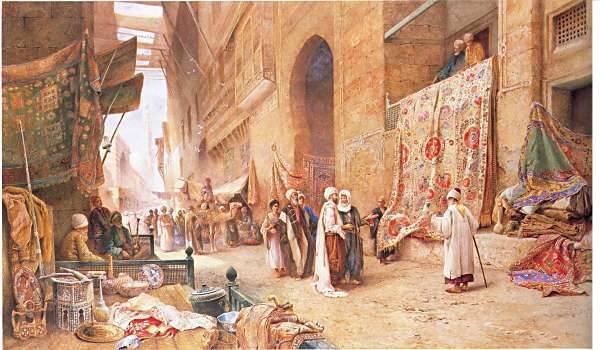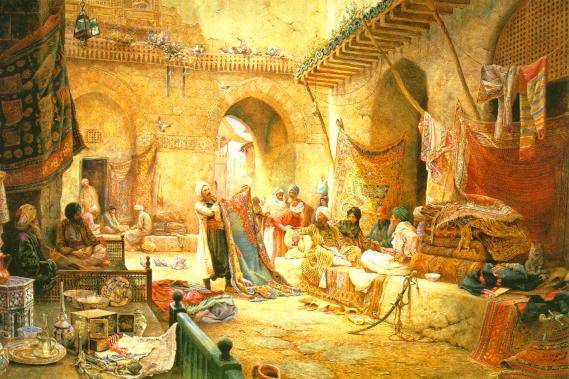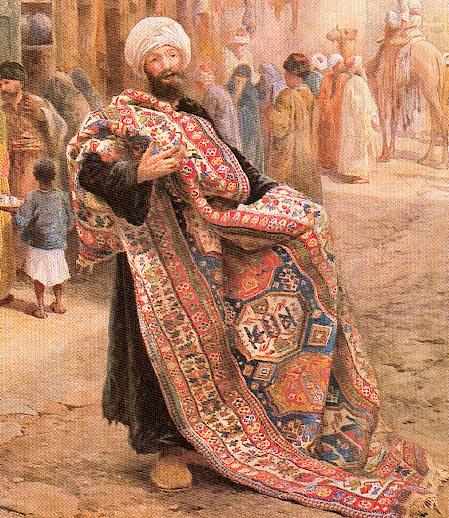Posted by Filiberto Boncompagni on 01-19-2004 12:45 PM:
Charles Robertson
Dear All,
I was very attracted by the realism of this watercolor even
if, as Thompson writes in the picture caption, the human figures were drawn to a
smaller scale to add "sense of drama" to the composition.

So the
discovery of this one was a little disappointing.

You don’t need to be Sherlock Holmes to notice that the display
of wares on the left side of both paintings is almost identical. My guess is
that the picture dated 1887 was done first; Robertson then decides to use the
same display of goods in the second one which I find more
alluring.
Robertson’s third picture, The Bazaar Khan El Khaleelee
Cairo is not dated but is "signed situated on an old label". That means we
can assume it was done in Cairo.
Actually, they are all watercolors, so
I think it is possible they all were made in Cairo. Probably the artist drew
first the backgrounds on the spot, then added the details in a quieter place.
Look at Caucasian rug in the last picture and at the seller holding it
in position:

even if the
watercolor is a fast technique, that level of detail requires time and
tranquillity. A Bazaar full of curious and noisy Egyptians is not exactly the
ideal place to work, but a private courtyard could be suitable enough.
But
that also means the presence of those Caucasian rug - and the Uzbek Suzani - is
plausible…
What do you think?
Regards,
Filiberto
Posted by Steve Price on 01-19-2004 01:19 PM:
Hi Filiberto
Since you mention the suzani, I call your attention to
the fringe on its bottom end. This is almost surely an embellishment by the
artist. The suzani also appears to "drape" more like a fine pile carpet than a
linen ground embroidery.
Regards,
Steve Price
Posted by Marvin Amstey on 01-19-2004 05:23 PM:
The fringe could have been added by the owner of the Suzani or one of the
embroiderers. An analogy would be the fringes added to embroidered Chirpys. BTW,
Filiberto, this is great essay; thanks.
Posted by Marvin Amstey on 01-19-2004 05:35 PM:
Colors
Tell me if I'm wrong, but I would guess that the purplish-blue (ugly) color
shown in detail 4 represents a late painting in his career. This color looks
like the awful colors in late 19th-early 20th century Turkish rugs. I doubt that
this color was present in rugs before 1875, and since he lived to 1891, and
assuming that the representation is accurate, the painting was done near the end
of his career. How's that for a Sherlock Holmes approach?
Posted by Steve Price on 01-19-2004 06:09 PM:
Hi Marvin
Concerning the fringe: it is possible that a fringe was sewn
onto the suzani by the owner, I suppose, just as fringes were routinely added to
chyrpy. I've seen lots of chyrpy with fringe on them, and it's said that the
fringe was sometimes replaced because it wore before the body of the garment
did. But I've never seen or heard of a fringe on a suzani. That doesn't mean
it's impossible that some existed, but they were certainly uncommon if they
existed at all. On that basis, I'd take the position that the probability that
this is what the painting shows is very small. It's surely much smaller than the
probability that the painter added it because he didn't really know what a
suzani is.
Regards,
Steve Price

Posted by Marvin Amstey on 01-19-2004 07:28 PM:
Based on probability, I'd say that the p-value of your thinking is about
0.5
Posted by Steve Price on 01-19-2004 08:14 PM:
Hi Marvin
Let's look at the possible explanations for the fringe on
the suzani in the painting:
1. Maybe it was a suzani with a fringe sewn on.
I've never seen or heard of a suzani with an applied fringe. For that reason, I
give this a very low probability of being the correct explanation. I assume that
you've never seen or heard of such a suzani either, but that doesn't stop you
from thinking that this is probably what it is.
2. Maybe it was a rug with a
suzani-like design, not really a suzani at all. I've never seen such a rug or
heard of one. For that reason, I give this a very low probability of being the
correct explanation. Do you think it's likely to be correct? If not, why? Bear
in mind, please, that you've already rejected "I've never seen or heard of such
a thing" as a strong argument.
3. Maybe the painter saw the scene with a rug
in that spot, but opted to use a suzani design because he's seen a suzani from a
little distance and really liked it, and didn't realize that it wasn't a rug and
had no fringe. Painters do such things, I'm told, so it seems plausible to me. I
give this a moderate probability of being the correct explanation. Where do you
put it relative to the first two explanations? Why?
4. Maybe the painter saw
the suzani, which had no fringe, but he added the fringe because he thought
suzani normally have one but that it was worn away, so he put it back on in the
painting. Painters do such things, I'm told, and for that reason I give this a
fairly high probability of being correct, much higher than explanations 1 or 2,
and somewhat higher than 3.
Your stated position is that explanation
number 1 is more likely than number 4. Do you have a rationale for that position
more compelling than the fact that that it is plausible? If you believe it to be
more plausible than any of the other three, what leads you to that
conclusion?

Regards,
Steve Price
Posted by Patrick Weiler on 01-20-2004 12:44 AM:
deja vu
Filiberto,
Not only are the wares similar, but the rugs are the same,
too. The Karachoph Kazak at the left of both paintings is the same, and it
appears that the green-ground rug being held up in the second painting is the
same as the one to the right of the suzani in the first painting.
This leads
one to think that the rugs were from the artist's studio and not painted from
life.
One disturbing painting is the Harem Pool painting. What is the
likelihood of a Euopean painter being invited into a harem?
Wishfully
yours,
Patrick Weiler
Posted by Filiberto Boncompagni on 01-20-2004 03:44 AM:
Steve,
My opinion about the fringe on the Suzani:
From what I see
in these three paintings, Robertson drew objects with remarkable accuracy.
Perhaps he took some liberties with sizes and composition, but the rendering of
the single elements seems very faithful - see in particular the Chajli (oops! I
said it) in the last picture I showed above.
That makes me think that the
suzani HAD a fringe.
Unless…Unless Robertson felt that the suzani was
visually incomplete without a fringe, so he added it.
I give a 80% to the
first hypothesis and 50% to the second.
Marvin, about the date of the
painting.
It is a watercolor, so IF it’s true what I found i.e. Robertson
worked exclusively with oil until 1880, and exclusively with watercolors after
1884, we can situate the dating between 1880 and 1891, with more probability
between 1884 and 1891. (Elementary Dr. Watson!)
Patrick,
Not only some
rugs are the same, but also other objects of the display, like the inlaid table,
the bottle, the brass tray and vessels. Even the sword, whose hilt is visible in
detail 4 could be probably the same sword leaned on the step on the right in the
1887 painting.
It all belonged to Robertson? Perhaps. Perhaps
not.
It depends on the possibility of Robertson having painted those
watercolors in Cairo, like the label on the third painting seems to suggest.
If this is the case I tend to believe that the objects, rugs included, were
in Cairo.
Let’s not forget that Egypt - if I’m not mistaken - didn’t have a
production of piled rugs anymore and it depended upon foreign supply - just like
the West.
Anyhow, we need more information on Robertson’s travels in the
M.E. Perhaps someone could help?
quote:
One disturbing painting is the Harem Pool painting. What is the likelihood of
a European painter being invited into a harem?
Thank you Pat, I was waiting for that!
Male artists were
not allowed into harems.
There were some exceptions, like Delacroix who had
the permit to visit the harem of the Dey’s Rais in Algiers in 1832.
The
painting Femmes d'Alger dans leur appartement (1834) is the result of the
sketches he made during that visit. It shows four CLOTHED women in their
apartment (the rugs are not clearly identifiable, so I do not post
it).
The baths are a different matter. It is known that western artists
were shown the inside of these baths WITHOUT the women, of course. The painters
later reconstructed the scene in their studios with the help of sketches and
photographs using professional models.
When you see Orientals scenes with
naked women you can surely bet that those scenes are a "studio
production".
Depictions of humans in the Orient presented various
problems to Western Painters.
I think we can discuss more about it, but
later.
Regards,
Filiberto
Posted by Steve Price on 01-20-2004 06:44 AM:
Hi Filiberto
You wrote, From what I see in these three paintings,
Robertson drew objects with remarkable accuracy. Perhaps he took some liberties
with sizes and composition, but the rendering of the single elements seems very
faithful - see in particular the Chajli (oops! I said it) in the last picture I
showed above. That makes me think that the suzani HAD a fringe.
I
guess it hinges on whether we think the fringe is something within the category
of things Robertson usually drew very accurately (details), or something within
the category of things with which he took liberties (size and composition).
We're not likely to find a way to know which it is.
Regards,
Steve Price
Posted by Horst Nitz on 01-23-2004 04:09 PM:
Hi,
I have only done a few aquarelles ever. But one thing I am pretty
sure about from my experience: these pictures contain by far too much detail to
have been worked out in detail on location. Most likely the artist has done
sketches and worked them out later back in his atelier with rugs draped out
(models?) that would have been available to him in London or elsewhere
(Caucasians?), but not the ones from the Egyptian basar.
Yours,
Horst Nitz
Posted by Filiberto Boncompagni on 01-24-2004 04:57 AM:
Hi Horst,
Some artists had their ateliers in Cairo, like the French
Charles-Theodore Frère (1814-1888). Some lived there for long time, like the
British John Frederick Lewis (1805-1876).
Unfortunately I don’t know how
long Robertson stayed in Cairo, but I think that it is possible that he made his
paintings there - even assembling elements from different sketches.
He used
watercolors, not oil. A well-lighted room and/or a private courtyard could have
been suitable as a studio for the "assembling" and the use of models - like the
one holding the Chajli in the third painting presented here.
The fact
that the third work is "signed and situated in Cairo" and the reasons discussed
in the "Karachopf Design" thread concerning the two others paintings, make me
confident enough… But, of course, in lack of further evidence this is only an
hypothesis.
Regards,
Filiberto





